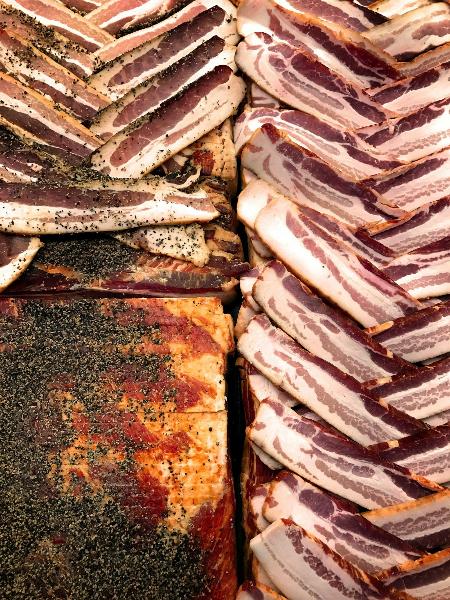Elk Meat 101: What Does Elk Taste Like and How to Cook Elk Steak for Delicious Results
Share
When it comes to wild game, elk is among the most prized meats you can put on your table. Hunters and food enthusiasts alike love elk for its clean, robust flavor, health benefits, and versatility in the kitchen. But many people still have questions, such as:
-
What does elk taste like?
-
How do you cook elk steak so it stays tender and juicy?
-
Is elk meat healthy?
At Wisconsin River Meats, where we proudly process wild game for hunters across the Midwest, we know elk deserves to be treated with respect. Whether you harvest elk yourself or buy premium elk cuts, this guide will help you understand elk flavor and teach you exactly how to cook elk steak to perfection.
What Is Elk Meat?
First, let’s define what elk meat actually is. Elk, also known as wapiti, is a large member of the deer family native to North America. Elk live on wild grasses, forbs, and shrubs, producing meat that is naturally lean, nutrient-rich, and free of antibiotics or growth hormones.
In the culinary world, elk is classified as a red meat similar to venison (deer), but many people consider it superior in taste and tenderness.
Why is elk becoming more popular?
-
It is high in protein
-
Naturally low in fat
-
Rich in iron and B vitamins
-
Ethically and sustainably harvested
-
Has a refined, mild flavor
Because of its clean, almost sweet taste, elk appeals to both wild-game newcomers and lifelong hunters.
What Does Elk Taste Like?
The best description of elk flavor is that it tastes similar to high-quality grass-fed beef, but with a richer, slightly sweeter and cleaner profile. It is much less gamey than traditional venison, making it approachable even for people who don’t usually eat wild meat.
Compared to beef, elk has:
-
A finer, tighter grain
-
Less marbling (which means lower fat)
-
A subtle earthy undertone
-
A mild sweetness from its wild forage diet
When you bite into a perfectly cooked elk steak, you’ll notice it is robust but smooth, with a tenderness that holds up well on the grill or in a skillet. There is no greasy aftertaste, and no strong gamey flavor, especially if the meat was field-dressed and processed properly.
In fact, many of our customers describe elk as “the best of beef, but cleaner,” which is why more chefs and foodies are making room for elk on their menus.
Is Elk Meat Healthy?
Yes — elk is among the healthiest red meats you can eat. Here’s why elk is such a great choice if you’re looking for clean, high-protein nutrition:
-
Low in saturated fat: elk has about half the fat of beef
-
High in protein: about 22–25 grams per 3-ounce serving
-
Rich in iron and B vitamins: supporting energy and healthy blood
-
Free of antibiotics and growth hormones: truly wild or responsibly ranch-raised
-
Low in cholesterol compared to other red meats
If you’re following a heart-healthy or low-fat diet, elk meat fits beautifully. And for anyone eating keto, paleo, or simply high-protein, elk is an ideal choice.
Best Ways to Cook Elk
Because elk is lean, the golden rule is do not overcook it. Elk behaves much like venison: its lack of fat means it cooks faster than beef, and if you leave it too long on high heat, you’ll end up with a dry, chewy steak.
The best ways to cook elk:
-
Sear hot and fast, then rest
-
Cook to medium-rare (125–130°F internal)
-
Let it rest at least 5 minutes before slicing
-
Add a bit of fat, such as butter, olive oil, or even bacon grease
-
Use aromatics like garlic, rosemary, thyme, or juniper berries
Slow cooking works beautifully for elk roasts or tougher cuts, but for premium elk steaks and tenderloin, high-heat, short cooking is the way to go.
How to Cook Elk Steak
If you’re asking “how to cook elk steak,” you’re in luck — elk steak is straightforward if you remember to avoid overcooking. Follow these steps for a tender, flavorful result every time.
Ingredients
-
Elk steaks, 1–1.5 inches thick
-
Kosher salt
-
Fresh cracked black pepper
-
Olive oil or avocado oil
-
1 tablespoon butter
-
Optional: fresh rosemary or thyme
Steps
-
Bring to room temperature. Remove the steaks from the refrigerator 20–30 minutes before cooking to help them cook evenly.
-
Pat dry. Use paper towels to remove surface moisture. Dry steaks brown better.
-
Season well. Sprinkle all sides with kosher salt and cracked black pepper. Elk’s natural flavor shines with simple seasoning.
-
Preheat a cast-iron skillet over medium-high heat with a drizzle of oil.
-
Sear for 2–3 minutes per side. You want a rich, brown crust.
-
Add a knob of butter and herbs during the last minute, basting the steak for extra richness.
-
Check internal temperature. Pull steaks off the heat when they reach 125–130°F for medium-rare.
-
Rest 5 minutes before slicing. This prevents juices from spilling out.
Elk Steak Grilling Option
You can also grill elk steaks over medium-high heat:
-
Oil your grill grates
-
Sear 2–3 minutes per side
-
Move to indirect heat if needed to finish cooking
-
Rest before serving
Elk steak pairs wonderfully with a simple compound butter made of fresh herbs, garlic, and a splash of lemon juice.
Common Mistakes When Cooking Elk
If you’re new to elk, avoid these common pitfalls:
-
Overcooking — the #1 mistake. Elk needs to stay medium-rare.
-
No resting — cutting elk too soon dries it out.
-
Too much seasoning — heavy marinades or spices can cover up elk’s beautiful mild flavor.
-
Forgetting to add fat — elk has little fat, so a touch of butter or oil goes a long way.
Great Side Dishes for Elk
Wondering what to serve with elk steak? These classic side dishes complement its rich but subtle profile:
-
Roasted root vegetables (carrots, beets, parsnips)
-
Wild rice pilaf
-
Grilled asparagus
-
Garlic mashed potatoes
-
Red wine–reduction sauce
-
Fresh green salad with a balsamic vinaigrette
Elk also pairs beautifully with bold Wisconsin cheeses, like aged cheddar or gouda, and a glass of robust cabernet or syrah.
Is Elk Tough or Gamey?
Properly handled elk is neither tough nor strongly gamey. Because elk roam on grass and wild herbs, their meat is naturally mild, slightly sweet, and tender.
Field dressing and prompt chilling after harvest are critical to keeping elk mild-flavored, but assuming good handling, elk is far less “gamey” than typical whitetail deer.
How to Marinate Elk Steak
You don’t have to marinate elk, but a short marinade can help boost moisture and flavor. Here’s a simple marinade recipe:
-
1/4 cup olive oil
-
2 tablespoons balsamic vinegar
-
2 cloves garlic, minced
-
1 tablespoon fresh rosemary
-
1 teaspoon black pepper
-
1/2 teaspoon salt
Marinate elk steaks for 2–4 hours, then pat dry before cooking. This prevents too much moisture from steaming the meat instead of searing it.
Other Ways to Cook Elk
Beyond steak, elk can be used in a variety of recipes:
-
Elk burgers (mix in 10–20% pork fat for juiciness)
-
Elk stew, simmered with red wine and root vegetables
-
Elk roast, slow-cooked with onions and garlic
-
Elk jerky, using classic Wisconsin spice blends
-
Elk sausages, with real hickory smoke
At Wisconsin River Meats, we’ve helped countless hunters turn elk trim and roasts into premium summer sausage, snack sticks, or jerky that stays flavorful for months.
Frequently Asked Questions
Is elk healthier than beef?
Yes, elk is lower in fat and calories, and higher in iron and B vitamins than beef.
Can you eat elk rare?
Yes, and you should — elk is safe to eat at medium-rare if properly handled and cooked.
Does elk have a strong flavor?
No — it is milder than venison and richer than beef, with a subtle sweetness.
How should I store elk meat?
Keep elk meat frozen if you aren’t using it within a few days, wrapped tightly to prevent freezer burn.
How long does cooked elk last in the fridge?
Like other cooked meats, about 3–4 days in a sealed container.
Why Wisconsin River Meats Loves Elk
At Wisconsin River Meats, we see elk as a perfect example of sustainable, healthy, wild-harvested protein. We proudly help hunters and customers process their elk using traditional, small-batch methods:
-
Authentic hardwood smoke
-
Custom spice blends
-
Careful trimming and grinding
-
Vacuum-sealed packaging for freshness
Whether you want elk steaks, snack sticks, summer sausage, or jerky, we’re honored to help you make the most of your elk harvest.
Final Elk Cooking Tips
Let’s recap the best practices for elk:
-
Cook steaks hot and fast, medium-rare
-
Rest after cooking
-
Use a thermometer
-
Add a touch of fat to balance leanness
-
Keep seasonings simple so elk’s natural flavor shines
If you’re branching out into elk for the first time, don’t be intimidated. Treat it gently, respect its lean character, and you’ll discover one of the finest red meats nature has to offer.
Elk Traditions in Wisconsin
Elk is not only delicious — it’s a piece of conservation history. After being nearly eliminated from Wisconsin over a century ago, wild elk have been successfully reintroduced and are now a symbol of wildlife recovery. Ethical hunting supports healthy herds, keeps populations in balance, and delivers one of the most sustainable wild meats in America.
When you enjoy elk steaks, roasts, or sausage, you’re tasting a legacy of conservation, community, and the Northwoods lifestyle.
How to Order or Process Elk
If you’ve harvested an elk and want to turn it into premium sausage or smoked meats, our team is ready to help. We offer:
-
Custom elk processing
-
Traditional summer sausage
-
Elk snack sticks
-
Hardwood-smoked elk jerky
-
Vacuum packaging for long storage
Visit our elk processing page here or stop by our Mauston location to learn more about how we can help you preserve your harvest with skill, safety, and old-fashioned pride.
Final Thoughts
Elk is one of the best wild proteins you can serve — rich, lean, and steeped in tradition. Whether you grill an elk steak with rosemary, slow-cook an elk roast with root vegetables, or slice elk summer sausage on a hunting trip, you’ll get bold, wholesome flavor that brings people together.
If you want to experience honest, handcrafted Wisconsin meat processing, Wisconsin River Meats is here to help you get the most out of every hunt. Reach out anytime with questions about elk cuts, sausage, or cooking — we’re passionate about supporting your wild food traditions.


1 comment
I am interested in buying elk steaks. Can you tell me all I need to know before I make a purchase please?